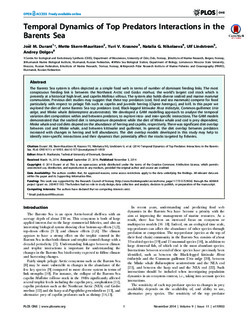| dc.contributor.author | Durant, Joël M. | |
| dc.contributor.author | Skern-Mauritzen, Mette | |
| dc.contributor.author | Krasnov, Yuri V. | |
| dc.contributor.author | Nikolaeva, Natalia G. | |
| dc.contributor.author | Lindstrøm, Ulf | |
| dc.contributor.author | Dolgov, Andrey V. | |
| dc.date.accessioned | 2015-01-29T15:49:48Z | |
| dc.date.available | 2015-01-29T15:49:48Z | |
| dc.date.issued | 2014-11-03 | |
| dc.identifier.citation | Durant JM, Skern-Mauritzen M, Krasnov YV, Nikolaeva NG, Lindstrøm U, et al. (2014) Temporal Dynamics of Top Predators Interactions in the Barents Sea. PLoS ONE 9(11): e110933. doi:10.1371/journal.pone.0110933 | nb_NO |
| dc.identifier.issn | 1932-6203 | |
| dc.identifier.uri | http://hdl.handle.net/11250/275072 | |
| dc.description.abstract | The Barents Sea system is often depicted as a simple food web in terms of number of dominant feeding links. The most conspicuous feeding link is between the Northeast Arctic cod Gadus morhua, the world's largest cod stock which is presently at a historical high level, and capelin Mallotus villosus. The system also holds diverse seabird and marine mammal communities. Previous diet studies may suggest that these top predators (cod, bird and sea mammals) compete for food particularly with respect to pelagic fish such as capelin and juvenile herring (Clupea harengus), and krill. In this paper we explored the diet of some Barents Sea top predators (cod, Black-legged kittiwake Rissa tridactyla, Common guillemot Uria aalge, and Minke whale Balaenoptera acutorostrata). We developed a GAM modelling approach to analyse the temporal variation diet composition within and between predators, to explore intra- and inter-specific interactions. The GAM models demonstrated that the seabird diet is temperature dependent while the diet of Minke whale and cod is prey dependent; Minke whale and cod diets depend on the abundance of herring and capelin, respectively. There was significant diet overlap between cod and Minke whale, and between kittiwake and guillemot. In general, the diet overlap between predators increased with changes in herring and krill abundances. The diet overlap models developed in this study may help to identify inter-specific interactions and their dynamics that potentially affect the stocks targeted by fisheries. | nb_NO |
| dc.language.iso | eng | nb_NO |
| dc.publisher | Public Library of Science | nb_NO |
| dc.rights | Navngivelse 3.0 Norge | * |
| dc.rights.uri | http://creativecommons.org/licenses/by/3.0/no/ | * |
| dc.title | Temporal Dynamics of Top Predators Interactions in the Barents Sea | nb_NO |
| dc.type | Journal article | nb_NO |
| dc.type | Peer reviewed | nb_NO |
| dc.subject.nsi | VDP::Agriculture and fishery disciplines: 900::Fisheries science: 920::Resource biology: 921 | nb_NO |
| dc.source.pagenumber | 9 p. | nb_NO |
| dc.source.volume | 9 | nb_NO |
| dc.source.journal | PLoS ONE | nb_NO |
| dc.source.issue | 11 | nb_NO |
| dc.identifier.doi | 10.1371/journal.pone.0110933 | |
| dc.relation.project | Norwegian Research Council: 200497/130 | nb_NO |

